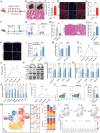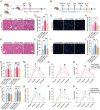Ccl2-Induced Regulatory T Cells Balance Inflammation Through Macrophage Polarization During Liver Reconstitution
- PMID: 39352304
- PMCID: PMC11615773
- DOI: 10.1002/advs.202403849
Ccl2-Induced Regulatory T Cells Balance Inflammation Through Macrophage Polarization During Liver Reconstitution
Abstract
Inflammation is highlighted as an initial factor that helps orchestrate liver reconstitution. However, the precise mechanisms controlling inflammation during liver reconstitution have not been fully elucidated. In this study, a clear immune response is demonstrated during hepatic reconstitution. Inhibition of the hepatic inflammatory response retards liver regeneration. During this process, Ccl2 is primarily produced by type 1 innate lymphoid cells (ILC1s), and ILC1-derived Ccl2 recruits peripheral ILC1s and regulatory T cells (Tregs) to the liver. Deletion of Ccl2 or Tregs exacerbates hepatic injury and inflammatory cytokine release, accelerating liver proliferation and regeneration. The adoption of Tregs and IL-10 injection reversed these effects on hepatocyte regenerative proliferation. Additionally, Treg-derived IL-10 can directly induce macrophage polarization from M1 to M2, which alleviated macrophage-secreted IL-6 and TNF-α and balanced the intrahepatic inflammatory milieu during liver reconstitution. This study reveals the capacity of Tregs to modulate the intrahepatic inflammatory milieu and liver reconstitution through IL-10-mediated macrophage polarization, providing a potential opportunity to improve hepatic inflammation and maintain homeostasis.
Keywords: inflammatory milieu; liver reconstitution; macrophage polarization; regulatory T cell; type 1 innate lymphoid cell.
© 2024 The Author(s). Advanced Science published by Wiley‐VCH GmbH.
Conflict of interest statement
The authors declare no conflict of interest.
Figures






References
MeSH terms
Substances
Grants and funding
LinkOut - more resources
Full Text Sources
